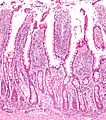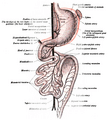Small intestine facts for kids
Quick facts for kids Small intestine |
|
|---|---|
 |
|
| Diagram showing the small intestine and surrounding structures | |
| Latin | Intestinum tenue |
| System | Digestive system |
| Artery | Superior mesenteric artery |
| Vein | Hepatic portal vein |
| Nerve | Celiac ganglia, vagus |
| Lymph | Intestinal lymph trunk |
The small intestine is a long, winding tube in your body. It connects your stomach to your large intestine. In people over 5 years old, it can be about 5 to 6 meters long! This is where most of your food gets digested and its nutrients are absorbed into your body.
Contents
What are the parts of the small intestine?
The small intestine has three main sections, each with a special job:
The Duodenum: Where Digestion Starts Strong
The duodenum is the first and shortest part of your small intestine. It's shaped like a "C" and is about 20-25 centimeters (8-10 inches) long. This is where most of the serious digestion work begins!
It gets special liquids from your pancreas and liver (called bile). These liquids help break down your food, especially fats and proteins. They also make the super-acidic food from your stomach less acidic, so it doesn't hurt the rest of your intestine.
The Jejunum: Absorbing Nutrients
The jejunum is the middle part of your small intestine. It's about 2.5 meters (8 feet) long. This section is super important because it has many tiny folds and finger-like bumps called villi. These folds and villi make the surface area huge, like a giant sponge!
This large surface area helps your body absorb most of the good stuff from your food. Things like sugars, amino acids (the building blocks of protein), and fatty acids are absorbed here. They then move into your bloodstream to power your body.
The Ileum: The Final Absorption Stage
The ileum is the last section of your small intestine. It's about 3 meters (10 feet) long. Like the jejunum, it also has villi to help with absorption.
The ileum's main job is to absorb things that weren't fully taken in by the jejunum. This includes important things like vitamin B12 and special bile salts. Once the ileum is done, the remaining food waste moves into your large intestine.
Images for kids
-
Micrograph of the small intestine mucosa showing the intestinal villi and crypts of Lieberkühn.
-
Small intestine in situ, greater omentum folded upwards.
See also
 In Spanish: Intestino delgado para niños
In Spanish: Intestino delgado para niños






